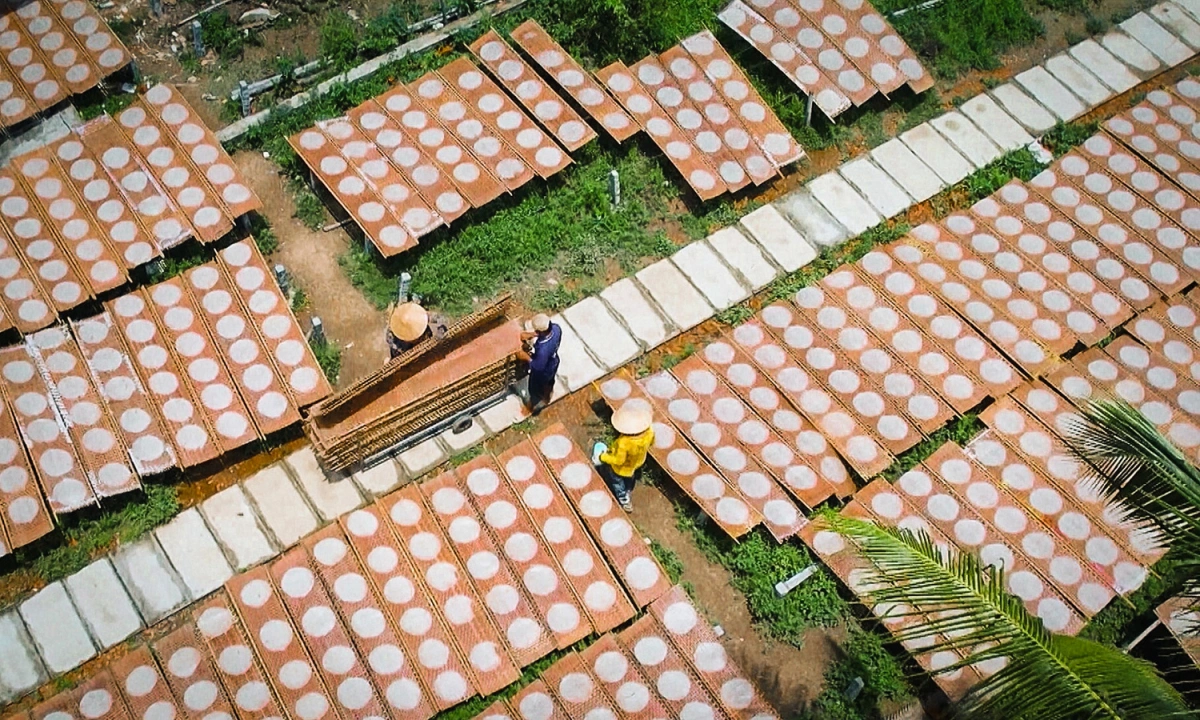Rice paper holds a significance in the south, akin to Tay Ninh rice paper in the southeast and Thuan Hung rice paper in the southwest (Mekong Delta).
Thuan Hung craft village in Thot Not District of Can Tho City was established in the mid-1800s. The craft of producing rice paper here was officially designated as an intangible cultural heritage by the Ministry of Culture, Sports, and Tourism in May.
Upon visiting Tan An Hamlet in Thuan Hung Ward on July 15, 29-year-old Nguyen Dinh Hoang Khanh from HCMC observed a scene with drying racks fashioned from coconut leaves lining the banks of Thom Rom Canal. These racks held hand-rolled rice paper, arranged for drying under the sun.
Although rice paper is a familiar delicacy, often reminiscent of childhood for many like Khanh, this marked the first time he had the chance to witness the stages involved in its creation.
Duong Thi Cam Dung, a rice paper artisan in Tan An Hamlet, shared that the paper is made from locally produced rice flour in Thot Not, aged for around six months.
"Using fresh rice results in the paper breaking apart when dipped in water and lacking crispness after baking. On the other hand, if older rice is used, the cake loses its sweetness," Dung explained.
The Thuan Hung community guards a secret concerning the flour-to-water ratio. This ensures that, as the water evaporates, the resulting cake maintains an optimal thickness - neither too thin and prone to tearing, nor too thick.
In the rice paper crafting process, three persons work in tandem, each responsible for a specific stage: spreading the batter, laying the rice paper, and facilitating the drying process.
The art of spreading the batter demands skill to achieve a round shape. The batter, portioned using a small coconut shell, is poured onto a flat, handled pan while the previous batch cooks.
Following this, the batter is poured evenly by spreading it about three times with the flat pan bottom. Lack of experience or rushing can result in uneven rice paper that might crack and break while drying.
The batter is poured and cooked on a cloth placed over a pot of simmering water. Rice husk stoves are traditionally used by the Thuan Hung community for rice paper production. A spatula made of coconut leaves is then pressed down for around 10 seconds to ensure even cooking.
The cooked product is lifted from the steamer using a specialized towel-wrapped tool. Given its dampness, the paper can easily adhere to the fabric. The artisan adeptly lays the rice paper flat on the drying rack. Due to the thinness of the cooked layer, extra care is needed to prevent tearing.
Each rice paper is 40 centimeters in diameter, fitting the dimensions of the drying rack. The moist paper layer clings to each bamboo slice, creating concealed patterns.
Drying the rice paper involves letting it dry for about 30 minutes. This retains some moisture, lending the paper resilience and preventing brittleness or easy breakage. Rain can make the paper wet and mushy, causing it to fall apart. At the same time, artisans need drying skills to maintain the rice paper's round shape.
The now-dry paper no longer appears white but transparent. The artisans gently detach each paper from the rack, folding them into stacks before smoothing the surface.
Choosing ingredients carefully and following precise techniques create rice paper that's soft, flexible, and filled with the aroma of rice. Khanh noted that this quality contributes to the identity of the traditional craft village.
Today, six rice paper variants are crafted: dipped rice paper, rice paper for spring roll, chili-infused rice paper, coconut-flavored rice paper, sweet rice paper, and rice paper with fermented shrimp sauce. Various sizes are available for each type.
Thuan Hung rice paper can be found at markets, local stores, supermarkets, or can be directly ordered from Thuan Hung makers. It is also exported to Cambodia.
Thuan Hung craft village is currently home to approximately 100 households across four hamlets that are engaged in rice paper production. While only a few households have adopted mechanized methods, the majority still adhere to manual craftsmanship.
The tradition has been preserved and passed down over the past two centuries in the form of heritage.
"Crafting authentic rice paper demands skill and effort. Thankfully, the dedication of the community has yielded recognition for the craft village as a national intangible cultural heritage, instilling local pride," Khanh said.















